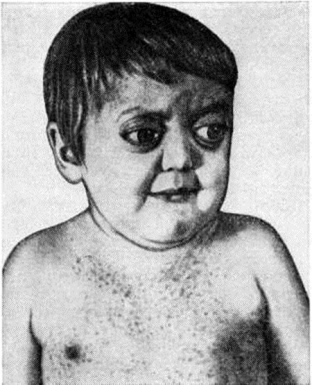The presence of congenital metabolic disorders manifests itself in the first weeks of a child's life. Some disorders are diagnosed much later. It is possible to identify metabolic disorders not only with the help of laboratory diagnostics, but also when examining the fundus, which reveals specific changes in certain types of disorders. What eye lesions are observed in metabolic disorders?
How are the eyes affected in case of lipid metabolism disorders?
Metabolic disorders of the lipid profile are accompanied by a malfunction of enzymatic processes, resulting in the deposition of lipids in cells of neuroectodermal origin. These conditions include amaurotic idiocy, which manifests itself after the 4th month of a child's life.
Amaurotic idiocy is characterized by muscle weakness, convulsions, and damage to the visual apparatus. Fundus changes are due to lipid infiltration leading to retinal thickening and are presented as grayish-yellow staining of retinal tissue near the macular area. Against the background of a pale retina, the macula has a rich red color. Narrowing of the arteries leads to pallor of the optic disc. Metabolic disorders of the lipid profile are externally manifested by strabismus and nystagmus.
Niemann-Pick disease manifests itself at 3-6 months of a child's life by the presence of hepatolienal syndrome and yellowing of the skin. Lipids are deposited in retinal ganglion cells, after which there is a yellowish tint around the macular area. The optic disc also turns yellow.
Gaucher disease is characterized by small hemorrhages in the retina and yellowish thickening of the conjunctiva in the form of triangles, which face the limbus with their base.
What are congenital metabolic disorders of protein nature?
Deposits of cystine crystals in cystinosis are visualized as yellow needles or rods in the cornea, retina, vascular tract. Alkaptonuria is characterized by the absence of cleavage of homogentisic acid to its final products, being deposited in the tissues of the eye, which acquire a dark blue color. On the sclera, triangular blue areas are visualized, their base is facing the limbus.
 Albinism is accompanied by the absence of melanin pigment in the membranes of the eyeball. The iris acquires a grayish-red color. Against the background of aplasia of the yellow pigment, visual acuity is significantly reduced. There is photophobia due to lack of pigment in the iris.
Albinism is accompanied by the absence of melanin pigment in the membranes of the eyeball. The iris acquires a grayish-red color. Against the background of aplasia of the yellow pigment, visual acuity is significantly reduced. There is photophobia due to lack of pigment in the iris.
Diabetic cataract. In diabetes mellitus, in addition to damage to the vessels of the retina, other eye lesions are also observed. The most common manifestation of metabolic disorders in diabetes is the development of cataracts. It is characterized by the formation of rubeosis – newly formed vessels. These vessels penetrate into the angle of the anterior chamber and are the source of hemorrhages. The vitreous body and the lens are often damaged.
Metabolic disorders in diabetes are accompanied by the following eye lesions:
- formation of small point opacities in the superficial layers of the lens;
- presence of a large number of vacuoles in the lens;
- flaky opacities all over the lens.
Eye damage due to metabolic disorders due to mucopolysaccharidosis
Mucopolysaccharidosis is manifested by such external signs – saddle nose, broad face and skeletal deformities. At the same time, the eyes have a specific appearance: the eyelids are thickened, exophthalmos is noted, clouding of the milky color is noted over the entire area due to the defibration of the corneal plates and the accumulation of lipids between them. The corneal diameter is enlarged.
 Xanthomatous granuloma or Schüller-Christian disease is characterized by the deposition of xanthomatous masses in organs that are rich in endothelium. Defects of different sizes are formed in the bones. With damage to the bones of the skull, xanthomatous granulations can provoke paralysis of the oculomotor nerves and nystagmus. Exophthalmos occurs when the orbit is filled with xanthomatous masses.
Xanthomatous granuloma or Schüller-Christian disease is characterized by the deposition of xanthomatous masses in organs that are rich in endothelium. Defects of different sizes are formed in the bones. With damage to the bones of the skull, xanthomatous granulations can provoke paralysis of the oculomotor nerves and nystagmus. Exophthalmos occurs when the orbit is filled with xanthomatous masses.
Thus, metabolic disorders necessarily affect the condition and appearance of the eyes.









Add a comment